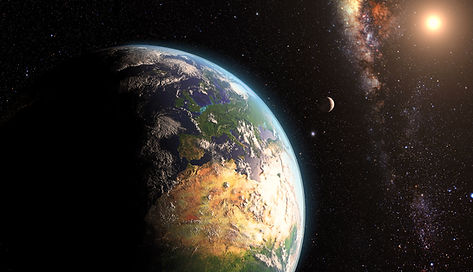



EARTH
The third planet from the Sun, The Earth is the fifth largest planet in the solar system. It is the only world in our solar system with liquid water at the surface. Just slightly larger than nearby Venus, Earth is the largest of the four inner, terrestrial planets, all of which are made of rock and metal.
The name 'Earth' is at least 1 000 years old. All of the planets, except for Earth, were named after Greek and Roman gods and goddesses. However, the name 'Earth' is a Germanic word, which simply means “the ground.”
Orbit and Rotation
As Earth orbits the Sun, it completes one rotation every 23.9 hours. It takes 365.25 days to complete one trip around the Sun. That extra quarter of a day presents a challenge to our calendar system, which counts one year as 365 days. To keep our yearly calendars consistent with our orbit around the Sun, every four years we add one day. That day is called a leap day, and the year it's added to is called a leap year.
Earth's axis of rotation is tilted 23.4° with respect to the plane of Earth's orbit around the Sun. This tilt causes our yearly cycle of seasons. During part of the year, the northern hemisphere is tilted toward the Sun and the southern hemisphere is tilted away. With the Sun higher in the sky, solar heating is greater in the north producing summer there. Less direct solar heating produces winter in the south. Six months later, the situation is reversed. When spring and autumn begin, both hemispheres receive roughly equal amounts of heat from the Sun.

CRUST
MANTLE
OUTER
CORE
Inner
CORE
Structure
Earth is composed of four main layers, starting with an inner core at the planet's centre, enveloped by the outer core, mantle and crust.
The inner core is a solid sphere made of iron and nickel metals about 1 221 km in radius. There the temperature is around 5 400 °C. The outer core is about 2 300 km thick, and comprised of iron and nickel fluids.
In between the outer core and crust is the mantle, the thickest layer. This hot, viscous mixture of plastic and molten rock is about 2 900 km thick. The outermost layer, Earth's crust, is about 30 km deep on average (Continental). Oceanic crust is thinner and extends about 5 km from the sea floor to the top of the mantle.
Surface
Like Mars and Venus, Earth has volcanoes, mountains and valleys. Earth's lithosphere, which includes the crust (both continental and oceanic) and the upper mantle, is divided into huge plates that are constantly moving. For example, the North American plate moves west over the Pacific Ocean basin, roughly at a rate equal to the growth of our fingernails. Earthquakes result when plates grind past one another, ride up over one another, collide to make mountains, or split and separate.
Earth's global ocean, which covers nearly 70 percent of the planet's surface, has an average depth of about 4 kilometres and contains 97 percent of Earth's water. Almost all of Earth's volcanoes are hidden under these oceans. Hawaii's Mauna Kea volcano is taller from base to summit than Mount Everest, but most of it is underwater. Earth's longest mountain range is also underwater, at the bottom of the Arctic and Atlantic oceans. It is four times longer than the Andes, Rockies and Himalayas combined.